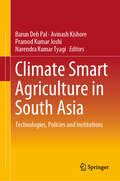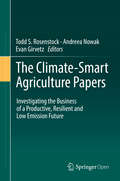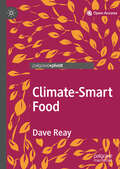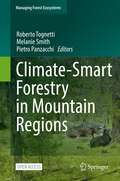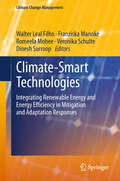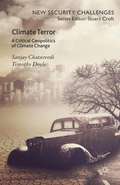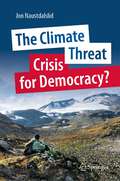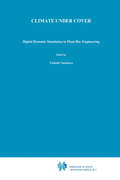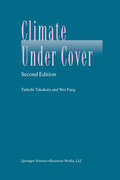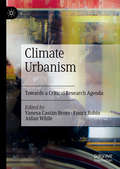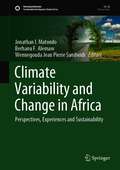- Table View
- List View
Climate Smart Agriculture in South Asia: Technologies, Policies and Institutions
by Barun Deb Pal Avinash Kishore Pramod Kumar Joshi Narendra Kumar TyagiThis book discusses various climate smart agro-technologies, their technical and economic feasibility across heterogeneous agro-climatic conditions, assessing farmers’ willingness to adopt those technologies, impact of climate smart technology in agricultural production and possible policy and investment opportunities to upscale it. Containing eight chapters, the book starts with a discussion about the methodological aspects of priority setting of the farm technologies across various regions of South Asia including Eastern Indo-Gangetic plain, Western Indo-Gangetic Plain and arid regions. Using data from field based trials and expert solicitations, the book next deliberates on a list of feasible technologies, assessed by constructing climate smart Feasibility Index. Further on, there is an analysis, using stated preference method, of the behaviour of farmers in adopting climate smart technologies. Preference of women farmers has been given a special focus in this book. After discussing the method priority setting of the farm technologies, impact of climate smart technologies has been analysed using real time data. Government policies have been reviewed with the view of achieving climate smart agriculture in South Asia. The book also describes the optimization modelling framework for investment allocation and technology prioritization. The model integrates both the bio-physical and the economic optimization model to capture the agro-climatic heterogeneity within the region and the variability of technical feasibility across regions and crops. Results of this model will help policy makers to identify how much to invest, where to invest and what technologies to prioritize for investments.
The Climate-Smart Agriculture Papers: Investigating The Business Of A Productive, Resilient And Low Emission Future
by Todd S. Rosenstock Andreea Nowak Evan GirvetzThis book is open access under a CC BY 4.0 license.This volume shares new data relating to Climate-Smart Agriculture (CSA), with emphasis on experiences in Eastern and Southern Africa. The book is a collection of research by authors from over 30 institutions, spanning the public and private sectors, with specific knowledge on agricultural development in the region discussed. The material is assembled to answer key questions on the following five topic areas: (1) Climate impacts: What are the most significant current and near future climate risks undermining smallholder livelihoods? (2) Varieties: How can climate-smart varieties be delivered quickly and cost-effectively to smallholders? (3) Farm management: What are key lessons on the contributions from soil and water management to climate risk reduction and how should interventions be prioritized? (4) Value chains: How can climate risks to supply and value chains be reduced? and (5) Scaling up: How can most promising climate risks reduction strategies be quickly scaled up and what are critical success factors? Readers who will be interested in this book include students, policy makers, and researchers studying climate change impacts on agriculture and agricultural sustainability.
Climate-Smart Food
by Dave ReayThis open access book asks just how climate-smart our food really is. It follows an average day's worth of food and drink to see where it comes from, how far it travels, and the carbon price we all pay for it. From our breakfast tea and toast, through breaktime chocolate bar, to take-away supper, Dave Reay explores the weather extremes the world’s farmers are already dealing with, and what new threats climate change will bring. Readers will encounter heat waves and hurricanes, wildfires and deadly toxins, as well as some truly climate-smart solutions. In every case there are responses that could cut emissions while boosting resilience and livelihoods. Ultimately we are all in this together, our decisions on what food we buy and how we consume it send life-changing ripples right through the global web that is our food supply. As we face a future of 10 billion mouths to feed in a rapidly changing climate, it’s time to get to know our farmers and herders, our vintners and fisherfolk, a whole lot better.
Climate-Smart Forestry in Mountain Regions (Managing Forest Ecosystems #40)
by Roberto Tognetti Melanie Smith Pietro PanzacchiThis open access book offers a cross-sectoral reference for both managers and scientists interested in climate-smart forestry, focusing on mountain regions. It provides a comprehensive analysis on forest issues, facilitating the implementation of climate objectives. This book includes structured summaries of each chapter.Funded by the EU’s Horizon 2020 programme, CLIMO has brought together scientists and experts in continental and regional focus assessments through a cross-sectoral approach, facilitating the implementation of climate objectives. CLIMO has provided scientific analysis on issues including criteria and indicators, growth dynamics, management prescriptions, long-term perspectives, monitoring technologies, economic impacts, and governance tools.
Climate-Smart Technologies: Integrating Renewable Energy and Energy Efficiency in Mitigation and Adaptation Responses (Climate Change Management)
by Walter Leal Filho, Franziska Mannke, Romeela Mohee, Veronika Schulte and Dinesh SurroopThe book addresses the perceived need for a publication with looks at both, climate smart technologies and the integration of renewable energy and energy efficiency in mitigation and adaptation responses. Based on a set of papers submitted as part of the fifth on-line climate conference (CLIMATE 2012) and a major conference on renewable energy on island States held in Mauritius in 2012, the book provides a wealth of information on climate change strategies and the role of smart technologies. The book has been produced in the context of the project "Small Developing Island Renewable Energy Knowledge and Technology Transfer Network" (DIREKT), funded by the ACP Science and Technology Programme, an EU programme for cooperation between the European Union and the ACP region.
Climate, Society and Elemental Insurance: Capacities and Limitations
by Kate BoothIn this book, world-leading social scientists come together to provide original insights on the capacities and limitations of insurance in a changing world. Climate change is fundamentally changing the ways we insure, and the ways we think about insurance. This book moves beyond traditional economics and financial understandings of insurance to address the social and geopolitical dimensions of this powerful and pervasive part of contemporary life. Insurance shapes material and social realities, and is shaped by them in turn. The contributing authors of this book show how insurance constitutes and is constituted through the traditional elements of earth, water, air, fire, and the novel element of big data. The applied and theoretical insights presented through this novel elemental approach reveal that insurance is more dynamic, multifaceted, and spatially variegated than commonly imagined. This book is an authoritative source on the capacities and limitations of insurance. It is a go-to reference for researchers and students in the social sciences – particularly those with an interest in economics and finance, and how these intersect with geography, politics, and society. It is also relevant for those in the disaster, environmental, health, natural, and social sciences who are interested in the role of insurance in addressing risk, resilience, and adaptation.
Climate, Society and Elemental Insurance: Capacities and Limitations
by Shaun French Kate Booth Chloe LucasIn this book, world-leading social scientists come together to provide original insights on the capacities and limitations of insurance in a changing world. Climate change is fundamentally changing the ways we insure, and the ways we think about insurance. This book moves beyond traditional economics and financial understandings of insurance to address the social and geopolitical dimensions of this powerful and pervasive part of contemporary life. Insurance shapes material and social realities, and is shaped by them in turn. The contributing authors of this book show how insurance constitutes and is constituted through the traditional elements of earth, water, air, fire, and the novel element of big data. The applied and theoretical insights presented through this novel elemental approach reveal that insurance is more dynamic, multifaceted, and spatially variegated than commonly imagined. This book is an authoritative source on the capacities and limitations of insurance. It is a go-to reference for researchers and students in the social sciences – particularly those with an interest in economics and finance, and how these intersect with geography, politics, and society. It is also relevant for those in the disaster, environmental, health, natural, and social sciences who are interested in the role of insurance in addressing risk, resilience, and adaptation.
Climate, Society and Subsurface Politics in Greenland: Under the Great Ice (Routledge Research in Polar Regions)
by Mark NuttallOnce imagined as a place on the very edge of the world, Greenland is now viewed as being at the epicentre of climate change. At the same time, international attention is focused on opportunities for oil and mineral development, seemingly made possible as the inland ice melts and sea ice disappears, revealing geological riches and making access to remote areas easier. In this book, Mark Nuttall takes the reader on a journey through landscapes, seascapes and icescapes of memory, movement and anticipation. Unravelling the entanglements of climate change, indigenous sovereignty and the politics surrounding non-renewable resource extraction, he describes how the country is on the verge of major environmental, political and social transformations as it aspires to greater autonomy and possible independence from Denmark. At the heart of this is discussion about how resources and the environment are given meaning and how they have become subject to intense political and ideological struggle. Climate, Society and Subsurface Politics in Greenland: Under the Great Ice is a key resource for academics, practitioners and students of anthropology, geography, development studies, political ecology and polar studies.
Climate, Society and Subsurface Politics in Greenland: Under the Great Ice (Routledge Research in Polar Regions)
by Mark NuttallOnce imagined as a place on the very edge of the world, Greenland is now viewed as being at the epicentre of climate change. At the same time, international attention is focused on opportunities for oil and mineral development, seemingly made possible as the inland ice melts and sea ice disappears, revealing geological riches and making access to remote areas easier. In this book, Mark Nuttall takes the reader on a journey through landscapes, seascapes and icescapes of memory, movement and anticipation. Unravelling the entanglements of climate change, indigenous sovereignty and the politics surrounding non-renewable resource extraction, he describes how the country is on the verge of major environmental, political and social transformations as it aspires to greater autonomy and possible independence from Denmark. At the heart of this is discussion about how resources and the environment are given meaning and how they have become subject to intense political and ideological struggle. Climate, Society and Subsurface Politics in Greenland: Under the Great Ice is a key resource for academics, practitioners and students of anthropology, geography, development studies, political ecology and polar studies.
The Climate System
by J. Berdowski R. Guicherit B. J. HeijThese results from the National Research Programme on Climate Change of the Netherlands offer a synthesis of present knowledge in the fields of: source and sinks of greenhouse gases and aerosols; land-atmosphere interactions; the global energy balance; and radiative forcing and climate variability.
The Climate System
by JAN BERDOWSKI; ROBERT GUICHERIT; BERTJAN HEIJThese results from the National Research Programme on Climate Change of the Netherlands offer a synthesis of present knowledge in the fields of: source and sinks of greenhouse gases and aerosols; land-atmosphere interactions; the global energy balance; and radiative forcing and climate variability.
Climate Terror: A Critical Geopolitics of Climate Change (New Security Challenges)
by Timothy Doyle Sanjay ChaturvediClimate Terror engages with a highly differentiated geographical politics of global warming. It explores how fear-inducing climate change discourses could result in new forms of dependencies, domination and militarised 'climate security'.
The Climate Threat. Crisis for Democracy?
by Jon NaustdalslidA key point in the book is the need to focus more seriously at the energy problem as the real problem behind global warming. The failure of global climate policies to reduce CO2 emissions and halt climate change has led an increasing number of scientist and activists to lose confidence in democracy's ability to handle climate change and led them to look to more authoritarian measures to meet the problem. The book documents these trends, also from a historical perspective, criticize them and sketches more democratic alternatives.
Climate, Ticks and Disease (CABI Climate Change Series #18)
by Saeed Alasmari Neil Alexander Abdelghafar Alkishe Reiko Arai Armanda Bastos Gervasio Henrique Bechara John Beier Giovanni Benelli Joshua Benoit Dennis Bente Richard Bishop Adrien Blisnick René Bødker Fernando Boinas Sarah Bonnet Nathalie Boulanger Alejandro Cabezas-Cruz Alexandre Rodrigues Caetano Cyril Caminade Jirí Cerny´ Roxanne Albertha Charles Ali Reza Chavshin Rosalind Cornforth Neil Coughlan Peter Cox Lauren Culler Milan Daniel Vlasta Danielova Mona Dehhaghi Maria Diuk-Wasser James P Duffy Olivier Duron Lars Eisen Rebecca Eisen Jana Elsterová Koray Ergünay Agustín Estrada-Peña Li-Qun Fang Natalia Fernández-Ruiz Erol Fikrig Serhii Filatov Durland Fish Janet Foley José De Fuente Roman Ganta Aysen Gargili Keles Robin Beat Gasser Abdul Ghafar Naftaly Githaka Lucy Gilbert Maryna Golovchenko Yuval Gottlieb Ernest Gould Jeremy Gray Libor Grubhoffer Gilles J. Guillemin Kayleigh M. Hansford Charles Hart John E. Healy Deborah Hemming Stephen Higgs Andrew Hoodless Yan-Jang S. Huang Bernard Hudson Chris Huntingford Peter Irwin Abdul Jabbar Nicholas Johnson Esther Kanduma Sirri Kar Maria Kazimirova Neil Kaye Thomas C. Kelly Lene Jung Kjaer Agatha Onyemowo Kolo Eduard Korenberg Nina Król Chi-Chien Kuo Timothy J. Kurtti Xavier De Lamballerie Patrick A. Leighton Hao Li L. Robbin Lindsay Wei Liu Geoffrey E. Lynn Ilya Maclean Ben J. Mans Maristela Martins de Camargo Karen D. McCoy Jolyon M. Medlock Ulrike G. Munderloh Atle Mysterud Sukanya Narasimhan Anna Obiegala Dasiel Obregón Alvarez Dr Nick H. Ogden Mari H. Ogihara Stefan Vilges Oliveira Charlotte Oskam Domenico Otranto Kennan J. Oyen Neha Pandey Hamed Kazemi Panahi A. Townsend Peterson John H. Pettersson Martin Pfeffer L. Paul Phipps Heather J. Plumpton Tatjana Pustahija Ram Raghavan Ryan O.M Rego Annapaola Rizzoli Isobel Ronai Franz Rubel Natalie Rudenko Benjamin Ruiwen Rufus Sage Abdallah M. Samy Gustavo Seron Sanches Isabel Kinney Santos Marcello Otake Sato Megumi Sato Richard Schloeffel Seyyed Javad Seyyed-Zadeh Ladislav Šimo Sunit Kumar Singh Daniel E. Sonenshine Morgan Sparey Frederic Stachurski Snorre Stuen Matias Pablo Szabó DeMar Taylor Mike Teglas Sam R. III Saravanan Thangamani Georgia Titcomb Attila J. Trájer Michael Turell Rika Umemiya-Shirafuji Dana L. Vanlandingham Laurence Vial Margarita Villar Richard Wall André B. Wilke G. R. Wint Jianhong Wu Zbigniew Zajac Xue ZhangThis book brings together expert opinions from scientists to consider the evidence for climate change and its impacts on ticks and tick-borne infections. It considers what is meant by 'climate change', how effective climate models are in relation to ecosystems, and provides predictions for changes in climate at global, regional and local scales relevant for ticks and tick-borne infections. It examines changes to tick distribution and the evidence that climate change is responsible. The effect of climate on the physiology and behaviour of ticks is stressed, including potentially critical impacts on the tick microbiome. Given that the notoriety of ticks derives from pathogens they transmit, the book considers whether changes in climate affect vector capacity. Ticks transmit a remarkable range of micro- and macro-parasites many of which are pathogens of humans and domesticated animals. The intimacy between a tick-borne agent and a tick vector means that any impacts of climate on a tick vector will impact tick-borne pathogens. Most obviously, such impacts will be apparent as changes in disease incidence and prevalence. The evidence that climate change is affecting diseases caused by tick-borne pathogens is considered, along with the potential to make robust predictions of future events. This book contains: Expert opinions and predictions. Global coverage of trends in ticks and disease. In-depth examination of climate change and tick distribution links. This book is suitable for researchers and students studying zoology, biological sciences, medical entomology, animal health, veterinary medicine, epidemiology, parasitology, and climate change impacts; and for those concerned with public health planning or livestock management where ticks and tick-borne pathogens pose a threat.
Climate Time Series Analysis: Classical Statistical and Bootstrap Methods (Atmospheric and Oceanographic Sciences Library #51)
by Manfred MudelseeClimate is a paradigm of a complex system. Analysing climate data is an exciting challenge, which is increased by non-normal distributional shape, serial dependence, uneven spacing and timescale uncertainties. This book presents bootstrap resampling as a computing-intensive method able to meet the challenge. It shows the bootstrap to perform reliably in the most important statistical estimation techniques: regression, spectral analysis, extreme values and correlation.This book is written for climatologists and applied statisticians. It explains step by step the bootstrap algorithms (including novel adaptions) and methods for confidence interval construction. It tests the accuracy of the algorithms by means of Monte Carlo experiments. It analyses a large array of climate time series, giving a detailed account on the data and the associated climatological questions.“….comprehensive mathematical and statistical summary of time-series analysis techniques geared towards climate applications…accessible to readers with knowledge of college-level calculus and statistics.” (Computers and Geosciences)“A key part of the book that separates it from other time series works is the explicit discussion of time uncertainty…a very useful text for those wishing to understand how to analyse climate time series.”(Journal of Time Series Analysis)“…outstanding. One of the best books on advanced practical time series analysis I have seen.” (David J. Hand, Past-President Royal Statistical Society)
Climate Time Series Analysis: Classical Statistical and Bootstrap Methods (Atmospheric and Oceanographic Sciences Library #42)
by Manfred MudelseeClimate is a paradigm of a complex system. Analysing climate data is an exciting challenge, which is increased by non-normal distributional shape, serial dependence, uneven spacing and timescale uncertainties. This book presents bootstrap resampling as a computing-intensive method able to meet the challenge. It shows the bootstrap to perform reliably in the most important statistical estimation techniques: regression, spectral analysis, extreme values and correlation. This book is written for climatologists and applied statisticians. It explains step by step the bootstrap algorithms (including novel adaptions) and methods for confidence interval construction. It tests the accuracy of the algorithms by means of Monte Carlo experiments. It analyses a large array of climate time series, giving a detailed account on the data and the associated climatological questions. This makes the book self-contained for graduate students and researchers.
Climate Trend Atlas of Europe Based on Observations 1891–1990
by Christian-D. Schönwiese J. RappClimate varies on all scales of time and space, bya large variety of reasons. However, before any discussion of reasons can be performed it is necessary to realize the very facts of climate variability by means of observations or reconstructions, respectively. In this book we focus on observed long-term trends of selected climate elements (tempera ture, precipitation, humidity, pressure ) as revealed by direct measurements of the Euro pean station network within the recent 100 years. Of course, there are a number of problems in detail: Reliability and accuracy of data, time series homogeneity, statistical confidence oftrends and so on. We hope that these problems are addressed in an instructive and, as far as possible, exhausting way. The main purpose of this work, however, was to provide a collection of trend charts which specify the regional particularities of observed climate trends in different months or seasons of the year leading us to an 'Atlas of observed climate trends in Europe'. Keeping in mind the recent World Meteorological Organization (WMO) climate nor mal (CLINO) period, we have also calculated the 1961-1990 trends.
Climate Under Cover: Digital Dynamic Simulation in Plant Bio-Engineering
by Tadashi TakakuraFrom mulching to greenhouses, the air space between the cover and the soil surface is the key to the classification of climates under cover. The same mechanism governs environments produced by the various covers. This book describes and analyses all the different environments from mulching to greenhouses. The relationship between plants and environment is another important topic in the book. Stress is placed on the link between quantitative phenomena and qualitative analyses. Most phenomena involved are nonlinear and non-steady-state. An approach called System Dynamics is used, and simulation models developed in the simulation language CSMP are fully used. The subjects covered are of relevance to graduate students, to scientists and researchers in agriculture and biological sciences and, of course, to agricultural organizations in both the developing and developed countries.
Climate Under Cover
by Tadashi Takakura Wei Fang1.1. INTRODUCTION Plastic covering, either framed or floating, is now used worldwide to protect crops from unfavorable growing conditions, such as severe weather and insects and birds. Protected cultivation in the broad sense, including mulching, has been widely spread by the innovation of plastic films. Paper, straw, and glass were the main materials used before the era of plastics. Utilization of plastics in agriculture started in the developed countries and is now spreading to the developing countries. Early utilization of plastic was in cold regions, and plastic was mainly used for protection from the cold. Now plastic is used also for protection from wind, insects and diseases. The use of covering techniques started with a simple system such as mulching, then row covers and small tunnels were developed, and finally plastic houses. Floating mulch was an exception to this sequence: it was introduced rather recently, although it is a simple structure. New development of functional and inexpensive films triggered widespread use of floating mulch. Table 1.1. The use a/plastic mulch in the world (after Jouet, 2001).
Climate Urbanism: Towards a Critical Research Agenda
by Vanesa Castán Broto Enora Robin Aidan WhileThis book argues that the relationship between cities and climate change is entering a new and more urgent phase. Thirteen contributions from a range of leading scholars explore the need to rethink and reorient urban life in response to climatic change. Split into four parts it begins by asking ‘What is climate urbanism?’ and exploring key features from different locations and epistemological traditions. The second section examines the transformative potential of climate urbanism to challenge social and environmental injustices within and between cities. In the third part authors interrogate current knowledge paradigms underpinning climate and urban science and how they shape contemporary urban trajectories. The final section focuses on the future, envisaging climate urbanism as a new communal project, and focuses on the role of citizens and non-state actors in driving transformative action. Consolidating debates on climate urbanism, the book highlights the opportunities and tensions of urban environmental policy, providing a framework for researchers and practitioners to respond to the urban challenges of a radically climate-changed world.
Climate Variability and Change in Africa: Perspectives, Experiences and Sustainability (Sustainable Development Goals Series)
by Jonathan I. Matondo Berhanu F. Alemaw Wennegouda Jean Pierre SandwidiThis book presents a comprehensive overview of climate variability and change in Africa, and includes impact assessments and case studies from integration frameworks, with a particular focus on climate, agriculture and water resources. Richly illustrated, the book highlights case studies from western, eastern and southern African region, and explores related development policies. Climate change adaptation research, prediction, and reanalysis are also addressed
Climate Variability and Change in High Elevation Regions: Past, Present & Future (Advances in Global Change Research #15)
by Henry F. DiazGlaciers in the Andes are particularly important natural archives of present and past climatic and environmental changes, in significant part because of the N-S trend of this topographic barrier and its influence on the atmospheric circulation of the southern hemisphere. Strong gradients in the seasonality and amount of precipitation exist between the equator and 30° S. Large differences in amount east and west of the Andean divide also occur, as well as a change from tropical summer precipitation (additionally modified by the seasonal shift of the circulation belts) to winter precipitation in the west wind belt (e. g. , Yuille, 1999; Garraud and Aceituno, 2001). The so-called 'dry axis' lies between the tropical and extra tropical precipitation regimes (Figure 1). The high mountain desert within this axis responds most sensitively to the smallest changes in effective moisture. An important hydro-meteorological feature on a seasonal to inter-annual time-scale is the occurrence of EN SO events, which strongly control the mass balance of glaciers in this area (e. g. , Wagnon et ai. , 2001; Francou et ai. , in press). The precipitation pattern is an important factor for the interpretation of climatic and environmental records extracted from ice cores, because much of this information is related to conditions at the actual time of precipitation, and this is especially so for stable isotope records. Several ice cores have recently been drilled to bedrock in this area. From Huascanin (Thompson et ai. , 1995), Sajama (Thompson et ai.
Climate Variability and Ecosystem Response at Long-Term Ecological Research Sites (Long-Term Ecological Research Network Series)
by David Greenland Douglas G. Goodin Raymond C. SmithThis volume in the Long-Term Ecological Research Network Series would present the work that has been done and the understanding and database that have been developed by work on climate change done at all the LTER sites. Global climate change is a central issue facing the world, which is being worked on by a very large number of scientists across a wide range of fields. The LTER sites hold some of the best available data measuring long term impacts and changes in the environment, and the research done at these sites has not previously been made widely available to the broader climate change research community. This book should appeal reasonably widely outside the ecological community, and because it pulls together information from all 20 research sites, it should capture the interest of virtually the entire LTER research community.
Climate Variability and Extremes during the Past 100 years (Advances in Global Change Research #33)
by Stefan Brönnimann Henry F. Diaz Tracy Ewen Jürg Luterbacher Urs Neu Richard S. StolarskiThis volume provides an up to date overview of climate variability during the 20th century in the context of natural and anthropogenic variability. It compiles a number of contributions to a workshop held in Gwatt, Switzerland, in July 2006 dealing with different aspects of climate change, variability, and extremes during the past 100 years. The individual contributions cover a broad range of topics. The volume fills a gap in this exciting field of research.
Climate Variability and Sunspot Activity: Analysis of the Solar Influence on Climate (Springer Atmospheric Sciences)
by Indrani RoyThis book promotes a better understanding of the role of the sun on natural climate variability. It is a comprehensive reference book that appeals to an academic audience at the graduate, post-graduate and PhD level and can be used for lectures in climatology, environmental studies and geography. This work is the collection of lecture notes as well as synthesized analyses of published papers on the described subjects. It comprises 18 chapters and is divided into three parts: Part I discusses general circulation, climate variability, stratosphere-troposphere coupling and various teleconnections. Part II mainly explores the area of different solar influences on climate. It also discusses various oceanic features and describes ocean-atmosphere coupling. But, without prior knowledge of other important influences on the earth’s climate, the understanding of the actual role of the sun remains incomplete. Hence, Part III covers burning issues such as greenhouse gas warming, volcanic influences, ozone depletion in the stratosphere, Arctic and Antarctic sea ice, etc. At the end of the book, there are few questions and exercises for students. This book is based on the lecture series that was delivered at the University of Oulu, Finland as part of M.Sc./ PhD module.
